Crosses
There are literally hundreds of different crosses used in heraldry; however, many of them are very uncommon. The cross was obviously a very popular charge in a religious age, especially during the Crusades. Clearly there are not too many distinct arms to be created using the simple straight-sided cross, so variations occurred from an early stage in heraldic design. As a general rule the early forms were fairly simple, and more complex ones developed later. Sometimes the development can be seen: for example the original cross pattée with splayed, sometimes “paw-shaped” ends led to paty = formy, patonce and flory which came to be seen as distinct charges (see the pictures below). In some cases it is not entirely clear which cross is meant, and sometimes the same arms are blazoned differently, for example Vescy is or a cross sable with the cross usually given as a cross flory or patonce.
 Known early forms include flory, formy, fourchy, moline, potent and the cross of Toulouse (as seen left on the arms of Raymond of Toulouse, d.1249). The blazon for this is gules, a cross clechy voided and botonny or. It has to be admitted that there is considerable confusion over the exact meaning of clechy – the simplest solution is that it describes the overall “keyhole”shape of the cross.
Known early forms include flory, formy, fourchy, moline, potent and the cross of Toulouse (as seen left on the arms of Raymond of Toulouse, d.1249). The blazon for this is gules, a cross clechy voided and botonny or. It has to be admitted that there is considerable confusion over the exact meaning of clechy – the simplest solution is that it describes the overall “keyhole”shape of the cross.
Some of the commoner crosses are shown below. Note that the spelling of terms can vary, e.g. fourchy or fourché(e).
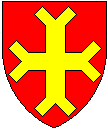
Cross fourchy
| 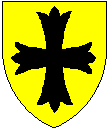
Cross patonce
(Vescy)
| 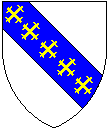
Crosses crosslet
(Loudham)
| 
Cross moline
|
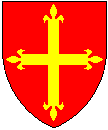
Cross flory
| 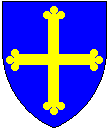
Cross botonny
| 
Cross potent
| 
Cross formy
|
If a cross such as formy reaches the edge of the shield it is described as throughout. A cross with a pointed base is fitchy. In the case of a cross with a flat end to the lower limb, it is possible for the pointed part to spring from that rather than the full width of the cross; in such cases the cross is fitched at the foot.

Cross formy
throughout
| 
Cross formy
fitchy
| 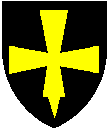
Cross formy
fitched at the foot
|
There are hundreds of other crosses, but they are uncommon. Some are strange, e.g. the cross gringolé which terminates in snakes’ heads! A very narrow cross is said to be a fillet cross, and one whose arms issue from a central square is quadrate.
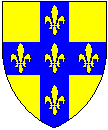 Crosses can of course be charged, for example Burton or on a cross azure five Fleur-de-Lis of the field [left].
Crosses can of course be charged, for example Burton or on a cross azure five Fleur-de-Lis of the field [left].
Back to the Glossary Contents
© Gill Smith 1997 – 1999
 Known early forms include flory, formy, fourchy, moline, potent and the cross of Toulouse (as seen left on the arms of Raymond of Toulouse, d.1249). The blazon for this is gules, a cross clechy voided and botonny or. It has to be admitted that there is considerable confusion over the exact meaning of clechy – the simplest solution is that it describes the overall “keyhole”shape of the cross.
Known early forms include flory, formy, fourchy, moline, potent and the cross of Toulouse (as seen left on the arms of Raymond of Toulouse, d.1249). The blazon for this is gules, a cross clechy voided and botonny or. It has to be admitted that there is considerable confusion over the exact meaning of clechy – the simplest solution is that it describes the overall “keyhole”shape of the cross.











 Crosses can of course be charged, for example Burton or on a cross azure five Fleur-de-Lis of the field [left].
Crosses can of course be charged, for example Burton or on a cross azure five Fleur-de-Lis of the field [left].